Probability density analysis of SINR in massive MIMO systems with matched filter beamformer①
Shu Feng (束 鋒)
(*School of Electronic and Optical Engineering, Nanjing University of Science and Technology, Nanjing 210094, P.R.China)(**National Mobile Communications Research Laboratory, Southeast University, Nanjing 210096, P.R.China)
?
Probability density analysis of SINR in massive MIMO systems with matched filter beamformer①
Shu Feng (束 鋒)②
(*School of Electronic and Optical Engineering, Nanjing University of Science and Technology, Nanjing 210094, P.R.China)(**National Mobile Communications Research Laboratory, Southeast University, Nanjing 210096, P.R.China)
This paper derives an approximate formula for probability density function (PDF) of received signal-to-interference-and-noise ratio (SINR) at user terminal when matched filter (MF) is adopted at a base station (BS). This distribution of SINR can be used to make an analysis of average sum-rate, outage probability, and symbol error rate of massive MIMO downlink with MF at BS. From simulation, it is found that the derived approximate analytical expression for PDF of SINR is consistent with the simulated exact PDF from the definition of SINR in medium-scale and large-scale MIMO systems.
massive MIMO, matched filter (MF), signal-to-interference-and-noise ratio (SINR), probability density function (PDF)
0 Introduction
Recently,massive multi-user MIMO (MU-MIMO) becomes an active research area in wireless communications due to its extremely high multiplexing, diversity gains, and fine spatial resolution[1-4]. It has been viewed as a strong candidate for key techniques of the future-generation wireless networks. In traditional MU-MIMO scenarios, several classic linear precoding schemes are developed like matched filter (MF),zero-forcing (ZF)[5,6], block diagonalization (BD)[7], maximum signal-to-leakage-plus-noise ratio (Max-SLNR)[8], singular value decomposition (SVD)[9], and channel inversion plus regularization including minimum mean square error (MMSE)[10,11]. These precoders can be readily extended to massive MU-MIMO systems. However, the beamforming performance in massive MU-MIMO is intimately related to pilot structures and degree of precision of channel estimation[4,12,13]. In Ref.[12], for the assumed channel characterized by the Gauss-Markov random process, a novel pilot design criterion is proposed to minimize the channel estimation mean square error such that sum-rate (channel capacity) is improved. In Ref.[13], an orthogonal pilot transmit scheme is proposed for multi-cell environment. Compared with non-orthogonal pattern, it can achieve an over 15dB signal-to-interference-and-noise ratio (SINR) gain.
The decomposition-based precoders such as ZF, BD, MMSE and Max-SLNR require about KN3complex multiplications (CMs) where N and K stand for the number of antennas at base station (BS) and the number of users in system, respectively. Thus, precoding complexity is a challenging issue as the number of antennas at BS approaches several hundred even one thousand. In Ref.[14], the authors design a reduced-complexity ZF precoder for massive MIMO. A truncated polynomial expansion of matrix inversion in Ref.[15] is applied to the regularized zero forcing to reduce the computational amount of matrix inversion and the corresponding coefficients are optimized to maximize the SINR in multi-cell MIMO system. However, the complexity of these precoding algorithms is still much larger than KN CMs (Complexity of MF). As a low-complexity precoder, MF tends to the optimal linear precoder SVD in the sum-rate sense from Refs[1-4] as N approaches large-scale.
In the development of precoding schemes, the main problem is how to find the probability density function of SINR in a massive MIMO system with MF precoder at BS. The solution of this problem is very important, because this PDF is necessary to compute the probability of symbol error and outage performance of massive MIMO. In Ref.[16], an approximate closed form expression of the PDF formula for SINR is derived and confirmed by simulation. But its expression is very complicated and not easily used to evaluate the PDF of SINR. In this paper, the auther derives a simple PDF formula for SINR when MF precoder is adopted at BS.
This paper is organized as follows. System model is described in Section 1. Section 2 presents the detailed deriving process and skills of the PDF of SINR. The numerical results are shown and discussed in section 3, and Section 4 concludes this paper.
Notations: throughout the paper, matrices, vectors, and scalars are denoted by letters of bold upper case, bold lower case, and lower case, respectively. Signs (·)H, (·)T, and Tr(·) denote matrix conjugate transpose, transpose, and trace, respectively.
1 System model
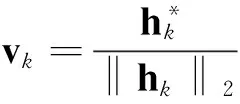

(1)

(2)
which can be written as

(3)
where
(4)
(5)
The sum-rate of all users is
(6)
2 Derived approximate PDF of SINR
For the convenience of deriving the PDF of the SINR defined in Eq.(3), it is firstly defined as
(7)
and
(8)
Without loss of generality, this paper rewrites Eq.(3) as
(9)
From Eq.(9), it is obvious that the auther can derive the probability density function (PDF) of γ provided if only the PDFs of x and y are known. Therefore, the first task is to calculate the PDF formulas of random variables x and y.
Random variable x in Eq.(7) is expanded as a sum of squares of 2N independent and identically distributed real Gaussian random variables
(10)

(11)
with
(12)
and
(13)
From the definition of ylin Eq.(8), ylis expanded as
(14)

Therefore, it is found that their means is
(15)
for all cases of k≠l or n≠m. Then, the expected value of y is given by
μy=E(yl)=0
(16)
and its variance is

(17)

(18)
Let us define
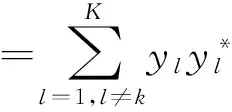
(19)
(20)

(21)
Considering random variables x and z are independent with each other, the joint probability of independent variables x and z is
fxz(x, z)=fx(x)fz(z)
(22)
In accordance with the definitions of γ, x and z, the relationship among them is as
(23)
with
(24)
Based on Eq.(24), using the Jacobian transformation, PDF of t can be derived as
(25)
Let define w=t+z, then PDF of random variable w is

(26)
where, CNK=Γ(N)Γ(K-1)
Considering
(27)
using the single-variable Jacobian transformation, the resulting PDF of the SINR γ is
(28)
(29)
where
(30)
Now, the derivation of the SINR PDF of user k is completed.
Using Eq.(29), the following average symbol error rate is readily attained
(31)
and average sum-rate
(32)
3 Simulation and discussion



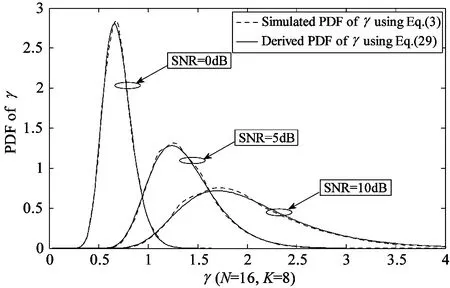
Fig.1 PDF of SINR (N=16, K=8)
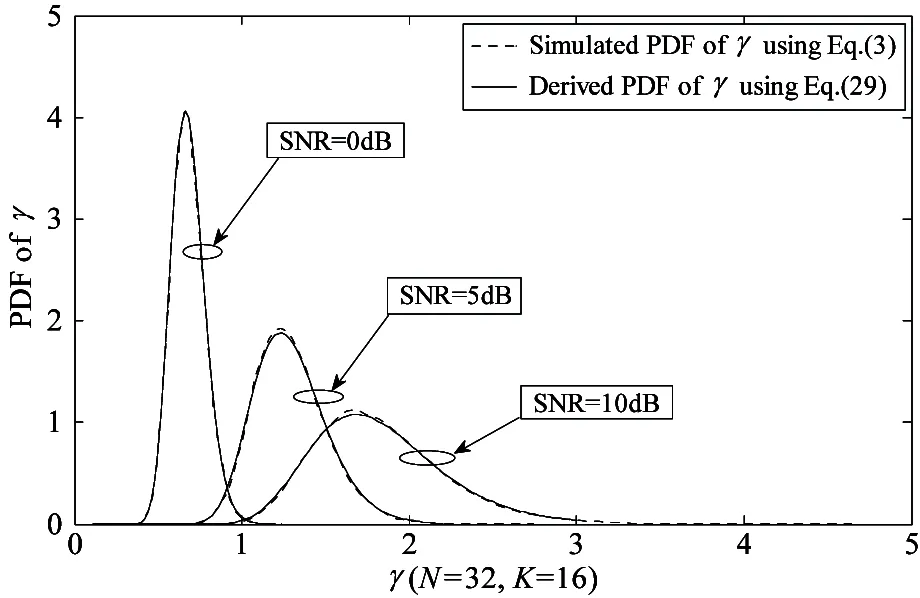
Fig.2 PDF of SINR (N=32, K=16)
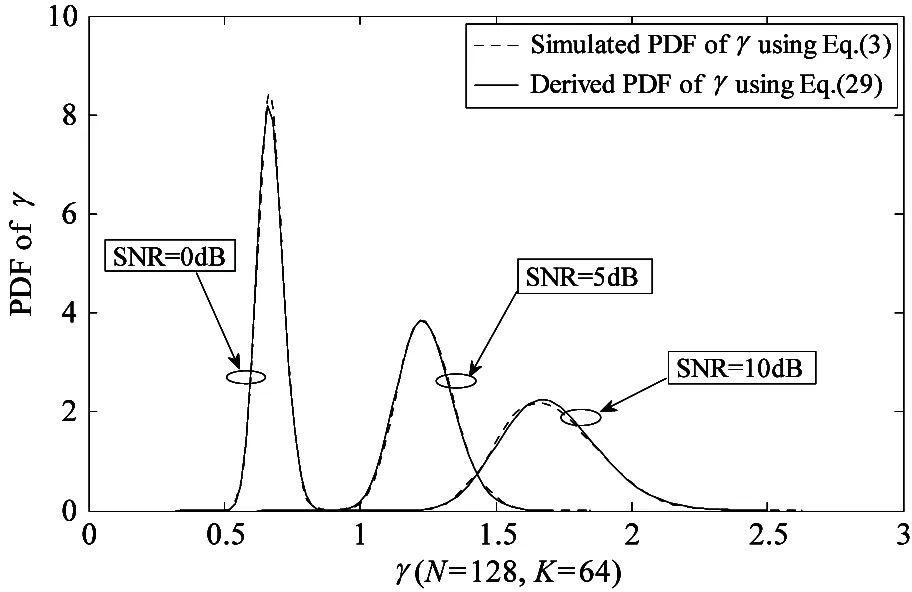
Fig.3 PDF of SINR (N=128, K=64)
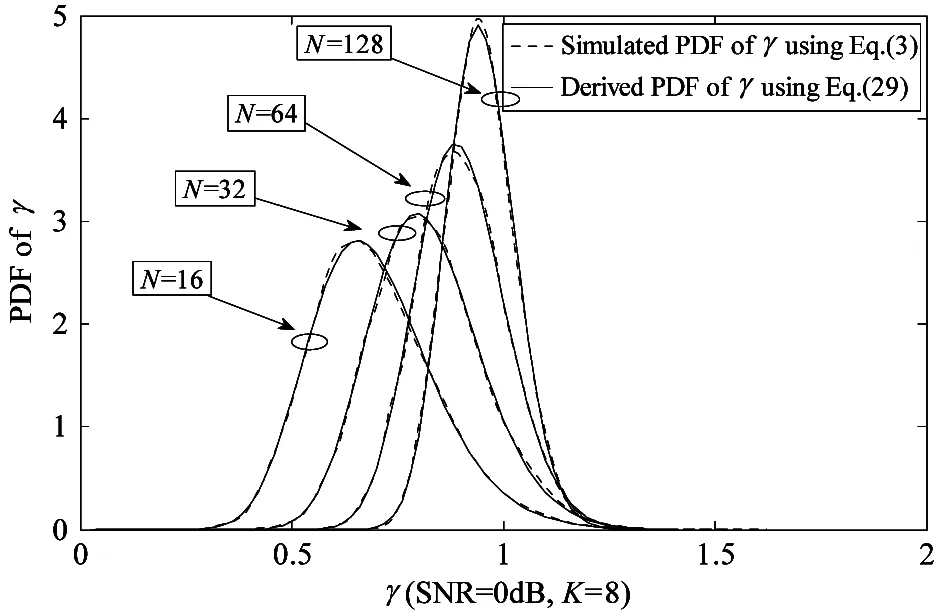
Fig.
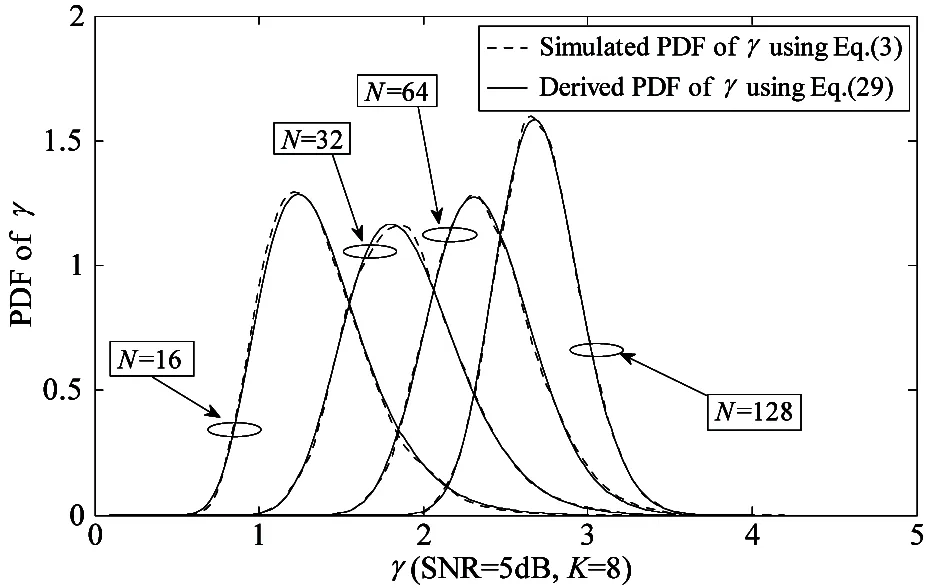
Fig.
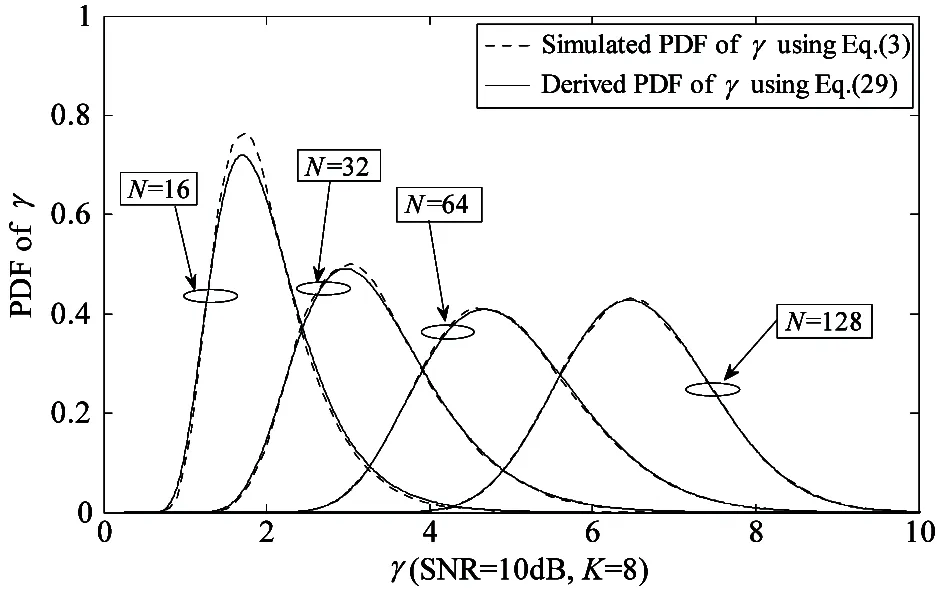
Fig.
4 Conclusion
A closed form approximate expression for the probability density function of SINR for medium-scale and large-scale MU-MIMO systems with MF beamformer is derived. It is confirmed that the derived closed form density function is very close to its counterpart obtained by simulation when N≥16. The procedure of using the derived function to calculate the probability of symbol error is presented, which can also be applied to analyze the outage probability and average capacity.
Reference
[ 1] Rusek F, Persson D, Lau B K, et al. Scaling up MIMO: Opportunities and challenges with very large arrays. IEEE Signal Process Mag, 2013, 30(1): 40-60
[ 2] Marzetta T L. Noncooperative cellular wireless with unlimited numbers of base station antennas. IEEE Trans Wireless Communications, 2010, 9(11): 3590-3600
[ 3] Larsson E G, Tufvesson F, Edfors O, et al. Massive MIMO for next generation wireless systems. IEEE Communications Mag, 2014, 52(2): 186-195
[ 4] Hoydis J, Brink S T, Debbah M. Massive MIMO in the UL/DL of cellular networks: How many antennas do we need. IEEE Journal Selected Areas Communications, 2013, 31(2): 160-171
[ 5] Spencer Q H, Swindlehust A L, Haardt M. Zero-forcing methods for downlink spatial multiplexing in multiuser MIMO channels. IEEE Trans Signal Processing, 2004, 52(2): 461-471
[ 6] Wiesel A, Eldar Y C, Shamai S. Zero-forcing precoding and generalized inverses. Zero-forcing precoding and generalized inverses. IEEE Trans. Signal Process, 2008, 56(9): 4409-4418
[ 7] Choi L U, Murch R D. A transmit preprocessing technique for multiuser MIMO systems using a decomposition approach. IEEE Trans Wireless Communications, 2004, 3(1): 20-24
[ 8] Sadek M, Tarighat A, Sayed A H. A leakage-based precoding scheme for downlink multi-user MIMO channels. IEEE Trans Wireless Communications, 2007, 6(5): 1711-1721
[ 9] Liu W, Yang L L, Hanzo L. SVD-assisted multiuser transmitter and multiuser detector design for MIMO systems. IEEE Trans Veh Tech, 2009, 58(2): 1016-1021
[10] Peel C B, Hochwald B M, Swindlehurst A L. A vector-perturbation technique for near-capacity multi antenna multiuser communication-part I: channel inversion and regularization. IEEE Trans Communications, 2005, 53(1): 195-202
[11] Hakjea S, Sang-Rim L, Inkyu L. Generalized channel inversion methods for multiuser MIMO systems. IEEE Trans Communications, 2009, 57(11): 3489-3499
[12] Noh S, Zoltowski M, Sung Y, et al. Pilot beam pattern design for channel estimation in massive MIMO systems. IEEE Journal Selected Topics Signal Process, 2014, 8(5): 787-801
[13] Fernandes F, Ashikhmin A, Marzetta T L. Inter-cell Interference in Noncooperative TDD Large Scale Antenna Systems. IEEE Journal Selected Areas Communications, 2013, 31(2): 192-201
[14] Park C S, Byun Y S, Bokiye A M, et al. Complexity reduced zero-forcing beamforming in massive MIMO systems. IEEE Information Theory and Applications Workshop,2014. 1-5
[15] Kammoun A, Muller A, Bjornson, E, et al. Linear Precoding Based on Polynomial Expansion: Large-Scale Multi-Cell MIMO Systems. IEEE Journal Selected Topics Signal Process, 2014, 8(5): 861-875
[16] Zhang W, Pan C, Du B, et al. Downlink SINR Study in Multiuser Large Scale Antenna Systems. Wireless Personal Communications, 2014, 79(2): 1539-1556
[17] Goldsmith A. Wireless Communications. Cambridge, England, UK: Cambridge University Press, 2005.168-176
Shu Feng, born in 1973. He received his Ph.D. degree from Southeast University, Nanjing, in 2002, an M.S. degree from XiDian University, Xi’an, in 1997, and a B.S. degree from Fuyang Teaching College, Fuyang, in 1994. From Sept. 2009 to Sept. 2010, he was a visiting post-doctorate researcher at the University of Texas at Dallas. In October 2005, he joined the School of Electronic and Optical Engineering, Nanjing University of Science and Technology, Nanjing, where he is currently a professor and supervisor of Ph.D. and graduate students. His research interests include wireless networks and array signal processing.
10.3772/j.issn.1006-6748.2015.03.007
①Supported by the National Natural Science Foundation of China (No. 61271230, 61301107), the Fundamental Research Funds for the Central Universities (No. 30920130122004) and Open Research Fund of National Mobile Communications Research Laboratory, Southeast University (No. 2013D02).
②To whom correspondence should be addressed. E-mail: shufeng@njust.edu.cn Received on Apr. 30, 2015***, Gu Chen*, Wang Jin*, Qian Zhenyu*, Lu Jinhui*
 High Technology Letters2015年3期
High Technology Letters2015年3期
- High Technology Letters的其它文章
- Improving the BER performance of turbo codes with short frame size based on union bound①
- Probabilistic data association algorithm based on ensemble Kalman filter with observation iterated update①
- A matting method based on color distance and differential distance①
- Edge detection of magnetic tile cracks based on wavelet①
- Diversity-multiplexing tradeoff of half-duplex multi-input multi-output two-way relay channel with decode-and-forward protocol①
- Design and analysis on four stage SiGe HBT low noise amplifier①
